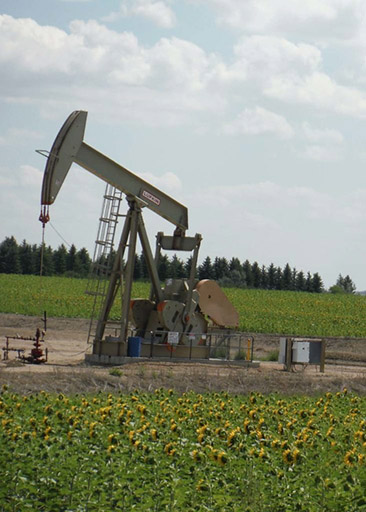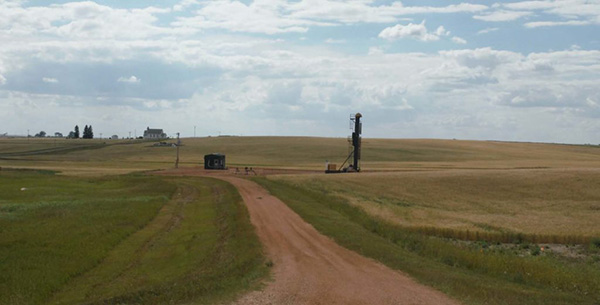Around Tioga, a small town in northwestern North Dakota, huge tractors, seeders, and sprayers lumber along the shoulders of the highways in spring. In midsummer, sunflowers turn yellow; tractor and skid-steer mowers turn fragrant alfalfa fields into cattle forage. Since 1951, hydrocarbon production has been an equally visible and valued part of the landscape around Tioga. Horse-head pumpjacks and tank batteries are everywhere. Heavy-duty pickups and guys (most oilfield workers are male) wearing gas-detection meters clipped to fire-resistant shirts are fixtures in Tioga. Huge tanker trucks are ever-present at the larger of Tioga’s two gas stations, owned by a farmers’ cooperative. Many people living in town and on surrounding farms own mineral rights which, like farmland, have passed through families since the homestead era. Those mineral acres can bring families small checks that subsidize their wages or millions that let farmers pay cash for six-figure farm equipment, or purchase better seeds, fertilizer, or crop insurance. Oil also brought well-recognized challenges to farming, from competing land and water use regimes to the threat of spills.

“A well-site set in a sunflower field.”
The mayor calls Tioga “an oilfield town,” says that almost everyone there is “either working in the oilfield or getting money from it.” He suggests something similar about farming and ranching. Thousands of fracked wells, thousands of miles of pipeline, occupy farmland around Tioga, which sits in the world-class Bakken oilfield. The broad cultural meanings of hydrocarbon production and agriculture—of the labor, land, water, and other capital they require—make the juxtaposition of hydrocarbons and farming around Tioga possible, even comforting. The work of remediation—technically, the removal of toxins from a medium—is one of the ways that people who live in, work in, or are otherwise invested in, spaces of joint hydrocarbon/crop production negotiate and reframe the uncertainties laid bare when oil or brine spills, which happens often. Whereas a few hours’ drive away at Standing Rock, the potential for an oil spill became the focus of a global movement rejecting the oil industry, throughout the Bakken, spills have become a feature of the landscape, like pumpjacks and flare stacks, winter snows or mid-summer’s bright yellow canola fields.
Pollution can be a subject-making process that applies scientific knowledge to techniques of government, shaping the social and biological lives of those in polluted sites, reifying the marginalization that catalyzes and exacerbates exposure to pollution (Auyero & Swistun 2009; Petryna 2013). Remediation processes around Tioga, in the Bakken generally, suggest a somewhat different socioecological experience of pollution. While pollution and remediation are integral to Bakken subjectivities, most of the region’s residents do not consider that process evidence of continuing histories of socioecological marginalization. Nearly continuous spills of oil, brine, or other industrial fluids—and their remediation—are an integral part of an uncertain but culturally-significant activity: joint hydrocarbon extraction and agriculture. Remediation in the Bakken seems more accurately described as management of the uncertainty inherent to that meaningful practice.
The governmental rationalities and techniques that I saw applied to spill remediation were often genuine attempts to manage the intrinsic uncertainty of joint extraction/agriculture. Remediation was just as often means of “focusing and intensifying critiques” of government action (Li 2007:277), critiques that eventually altered government of the hydrocarbon industry. At a public meeting in Williston, about an hour from Tioga, a meeting addressing oil and brine pipeline regulation, people laughed knowingly at someone’s joke that spills from trucks happen so often that they don’t make the news. Discussing how to address spills, an official with the North Dakota Industrial Commission (NDIC), which regulates the hydrocarbon industry, said, “Oversight is the first step.”; a sentiment echoed by an official at North Dakota’s Department of Health, Environmental Health Section (EHS), which oversees spill remediation. The EHS has received thousands of environmental incident reports over the life of North Dakota’s fracking industry, roughly a decade, an industry that continues expanding rapidly. Of that rapid expansion, an EHS official said, “it sparked a lot of regulation and change because it happened so fast.”
Over the last few years, the Bakken saw two large oil spills and a large brine spill; one oil spill near Tioga, the brine spill less than fifty miles away. Two of those landowners were at the above-mentioned meeting. Their public indignation or litigiousness would have been understandable, even expected. Yet at the meeting—and in other discussions I had with them—they seemed committed to public discussion with industry and government. At this public meeting, the NDIC official welcomed their input as fundamental to “prevention, protection [or mitigation], and detection” of spills. Their public and politically-charged commitment brought the EHS and NDIC, scientists, involved corporations and other landowners to the Williston meeting and to others like it. More than governmental “listening sessions,” such meetings altered hydrocarbon government: bringing landowner concerns to the forefront; increasing numbers of well-site and pipeline inspectors; initiating scientific investigation of the effects of spills and pipelines on soil quality.

“Pipeline markers at the edge of a wheat field. A rotaflex-style pump, a tank battery, a workover rig, and a drilling rig are all visible on the horizon.”
The numerous landowners, oil industry personnel, scientists, and officials that I heard speak on the subject at the Williston meeting and elsewhere regularly asserted that techniques for oil remediation are much more advanced than brine remediation techniques, and that even adequate remediation strategies are flawed. The NDIC official at the meeting said, “We’ve gotten a lot better […] Are we perfect? No.” He added, “Every solution you have has a potential drawback.” Those imperfections create openings through which effective critiques have been leveled at industry/government. Officials at the EHS prescribe remediation techniques according to the qualities and context of each spill. Companies deemed responsible for spills undertake remediation or pay subcontractors to do so, with EHS oversight. In an interview after the Williston meeting, a North Dakota State University researcher stressed that successful remediation also requires understanding landowner expectations. Also in a later interview, the aforementioned EHS official said remediation requires everyone involved to be “very flexible,” that the process can take hours or years, depending on the many permutations of a few key factors: What spilled? How much? How long ago? Did it happen on public land or private? Is the spill confined to a well site or pipeline easement? The sociocultural and environmental qualities and context of each oil and/or brine spill effectively determine how its toxicity is defined and addressed.
At the Williston meeting, landowners described years of remediation at their respective oil and brine spills, remediation involving the constant production of scientific data, constant interaction with government officials across multiple scales of government, constant alterations to the way they spend their days, the ways they make a living. They deal with non-disclosure agreements, companies being bought and sold, changing standards of toxicity. At no point did either of those landowners suggest that the imperfect remediation process required their denunciation, litigiousness, or activism. In a later conversation, one of those landowners said to me that when their spill happened, they approached the company responsible and told them that they expected the remediation process to be done correctly. In exchange, the landowner agreed to publicly defend the company, its remediation efforts. It’s too easy to suggest that the landowner just sold out. Instead, their concern was returning their land—in the family since it was first homesteaded—to its pre-spill condition, and also preventing the spill’s toxicity from infiltrating the aquifer or remaining in soils, protecting “future generations” from its toxicity. That EHS official said, “as bad as these [spills] were, something good has come out of [them].” Those changes included a new spill reporting system; new regulations; and new techniques for remediation and the related process of reclamation, which involves re-establishing soils’ ability to support crops or native plant communities.

“A rotaflex pump on a well site in a wheat field. A homestead era church and cemetery are in the background.”
The socioecological practices for dealing with a spill I’ve described here—remediation, discussion, regulation—seemed possible because most of those involved were culturally similar: middle-class, white, relatively conservative. Many people in and around Tioga farm and work in the oilfield not just because it makes them money, but because such work carries deep cultural meaning. To reduce those pursuits to mere economic interests would obviate historic and contemporary relationships between uncertainty, culture, and landscape that seem fundamental to remediation in rural North Dakota. The hardscrabble homesteader, the sod house, harsh weather, and crop failures; these were fundamental to individual and collective settler identities. With the oil industry, the hardscrabble roughneck, the man camp, and oil booms and busts came to occupy that familiar and valued cultural niche, where people (usually white men) work hard, in uncertain conditions, expecting and accepting uncertainty as inherent to the landscape. Crafting consistently improving responses is considered culturally-appropriate. Protests and lawsuits are not. Seen that way, Bakken remediation becomes an opportunity to reaffirm valued relationships between people and the place where they live. As anthropologists, we tend to seek those marginalized by racialized and gendered socioeconomic and environmental hierarchies. A comprehensive understanding of environmental government and politics, especially in the contemporary U.S., requires more research on people and places not easily placed in that slot.

1 Comment
Wow! Excellent job Nester, it was our pleasure to get to meet you when in Tioga, thank you…